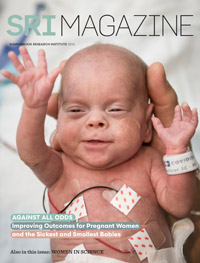The Alliance makes its move to reduce high stillbirth and preterm birth rates

Network of partners joins forces to ensure more women in Ontario carry their babies to full term
September 12, 2018

Dr. Jon Barrett is the medical director of the Alliance, which hopes to reduce the number of preterm deliveries in Ontario by 15%.
Dr. Jon Barrett’s discovery that delivering twins by planned caesarean section is no safer than planned vaginal delivery has significantly informed obstetrical care worldwide. The landmark study on twin births that led to the finding involved 2,804 women in 106 centres across 25 countries, and was published in 2013. Its home is The New England Journal of Medicine, the world’s leading general medical journal with a history extending over 200 years. Having his paper presented in what Barrett calls “the holy grail” for researchers was a momentous accomplishment; and, to commemorate the occasion, he framed the publication and hung it on his office wall. Barrett, however, found himself gazing at it, unmoved. ‘So what? Big deal,’ he said to himself. “I informed practice, but the trouble with informing practice is that it doesn’t change practice,” he says from his office at Sunnybrook, framed paper hanging feet away. As he contemplated the embodiment of 10 years’ work, his focus shifted to implementing knowledge, and not just in twin births, but also in preterm birth.
The World Health Organization defines preterm birth as delivery before 37 weeks of gestation. More than one in 10 babies, or 15 million, are born prematurely every year, with one million of these dying. Further, the incidence is rising. Complications from early birth are one of the leading causes of death among children under five years of age. In Canada each year about 8% of pregnancies are preterm, which translates to more than 25,000 premature babies. Because most survive with disabilities, and there’s a lifelong impact on the child as well as families and society, the estimated yearly cost on the country’s health care system exceeds $8 billion.
The Alliance will implement a “bundle of care”—treatments to prevent stillbirth and preterm birth, which include:
![]() Administering low-dose aspirin (75 mg) once per day to women with risk factors for pre-eclampsia, a precursor to early labour. Risk factors include previous pre-eclampsia, diabetes, renal disease and being pregnant with more than one baby.
Administering low-dose aspirin (75 mg) once per day to women with risk factors for pre-eclampsia, a precursor to early labour. Risk factors include previous pre-eclampsia, diabetes, renal disease and being pregnant with more than one baby.
Giving a daily dose of progesterone (200 mg) until 36 weeks’ gestation to women with a history of early birth or with short cervixes.
Measuring the length of the cervix routinely between 16 and 24 weeks’ gestation.
![]() Screening women at prenatal care intake for risk of preterm birth and stillbirth using health history and prior pregnancy registry data.
Screening women at prenatal care intake for risk of preterm birth and stillbirth using health history and prior pregnancy registry data.
Tying fetal awareness teaching into routine pregnancy care, and using prompt electronic fetal monitoring when fetal movement is much reduced.
Aims for select regions and groups in Ontario:
Doing more ultrasound screenings for prenatal patients at higher risk in northern Ontario.
Gaining approval of the Non-Insured Health Benefits Program for First Nations and Inuit to cover early labour prevention drugs.
Collaborating with Aboriginal Health Access Centres to improve outcomes.
Offering online pregnancy resources in Indigenous languages.
![]() Tailoring traditional, electronic and social media knowledge translation campaigns to populations with higher rates of stillbirth and preterm birth, including Aboriginal, black, and other racialized people and their families.
Tailoring traditional, electronic and social media knowledge translation campaigns to populations with higher rates of stillbirth and preterm birth, including Aboriginal, black, and other racialized people and their families.
Contrary to the state of affairs when Barrett began in the field—a period when nothing could be done to predict, prevent or treat premature delivery, he notes—research has advanced, and the growing problem of early birth can be addressed. The task now is to ensure knowledge gleaned through research is woven into practice widely to prevent preterm birth and save lives. Barrett says that to do this, researchers must collaborate instead of working “in pillars of academic isolation,” as many have done. The director of the Women & Babies Research Program and a senior scientist at Sunnybrook Research Institute (SRI) says, “One thing I’ve learned over the years is that you can’t do this in one network. You have to get multiple partners because it’s a complex problem.” His solution: the Ontario Alliance for the Prevention of Preterm Birth and Stillbirth, or simply, the Alliance.
The Alliance, which is a collaboration among families, hospitals, maternal-child networks in the health system and maternal-newborn care providers, has several goals. Barrett, the medical director of the Alliance, says the first priority is to drum up funding from the government and philanthropists to implement existing knowledge on predicting, preventing and treating preterm birth. “It’s a tragedy that babies are dying, yet we know we can prevent it,” says Barrett, who knew by the age of five that he wanted to follow in his late father’s footsteps by becoming an obstetrician. He says he could have applied for grants to assist in this endeavour, but typically, organizations like the Canadian Institutes of Health Research provide funding for research, not health care implementation. “It became very frustrating for me to know that there’s this body of evidence that can prevent babies from dying, but I’d have to wait on a 15% chance [of funding] rate in order to implement it. I’m not the kind of person who likes those odds.”
The second part of the project will entail getting blood samples from pregnant women in the first trimester, evaluating their DNA and protein levels, and correlating the findings with later outcomes, including those of their babies. Another objective is developing clinical trials to generate new knowledge. The Alliance will also instruct health care providers and parents-to-be on how to prevent stillbirth and preterm birth simply, safely and inexpensively; identify at-risk women by linking data with screening programs; and improve care coordination so that unavoidable cases of early labour happen in hospitals equipped to deal with them. Additionally, it will implement a “bundle” of standard treatments through its networks. If successful in achieving these goals, then the Alliance could usher in an era of support and understanding for families affected by preterm birth and stillbirth, which Barrett notes is lacking.
Dr. Nir Melamed, who is a member of the Alliance, says it strives to standardize care: “It doesn’t make sense that different physicians who are practising only a few kilometres from each other will do things so differently when it comes to the care of low- and high-risk pregnancies.” The associate scientist in the Women & Babies Research Program at SRI and maternal-fetal medicine specialist at Sunnybrook also says it will enable researchers to do joint projects. “There are some questions you simply don’t have enough patients in a single centre to address, so by doing multicentre studies we have [this] power.”
The expected outcomes of the Alliance are ambitious, but measurable. There could be a reduction in premature deliveries—a 15% drop is the aspiration—and stillbirths; a decline in the number of babies in neonatal intensive care units; a decrease in disability rates; and millions saved in health care costs.
Before the Alliance, Barrett, who is also a professor at the University of Toronto, founded the Greater Toronto Area-Obstetrical Network, which was fuelled by a similar desire to encourage collaboration. Since its inception in 2013 it has attracted the attention of specialists outside the GTA; to accommodate other centres, the name was modified to Southern Ontario Obstetrical Network. Better known as SOON, it will apply the Alliance’s strategies (see sidebar).
The Alliance isn’t the first network of its kind built on the premise of collaboration. Similar networks in Ireland, the Netherlands and the U.S. have been developed with great success, says Melamed, who is also an associate professor at U of T. “They’ve managed to conduct beautiful, amazing research through multicentre cooperation. That’s what we’re trying to replicate here.”
Launched at the end of 2017, the Alliance has high hopes, Melamed says. “We have a real opportunity. When you make a small change in your own hospital, you can affect a small number of patients. When you make a similar change across a much broader population, such as across the GTA or eventually throughout the whole province, what you do can have a much greater impact on the health of women and their babies.” As Barrett considers the road ahead, he says, “It’s time for the government, philanthropists and research funders to work together by putting patients first, and together with them, implement what we know, find out what we don’t, save lives and improve the health of all Canadians.”
Donor seed funding and the Canadian Institutes of Health Research are supporting the research of the Alliance, the latter through a grant to study outcomes in preterm birth.



